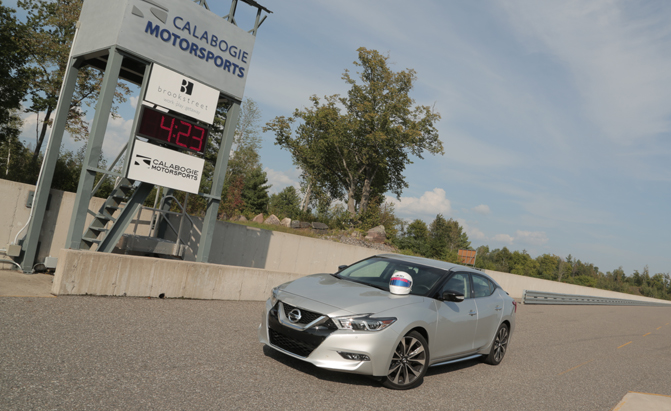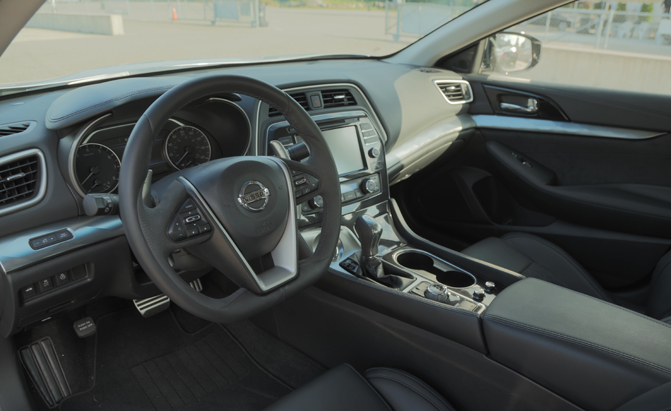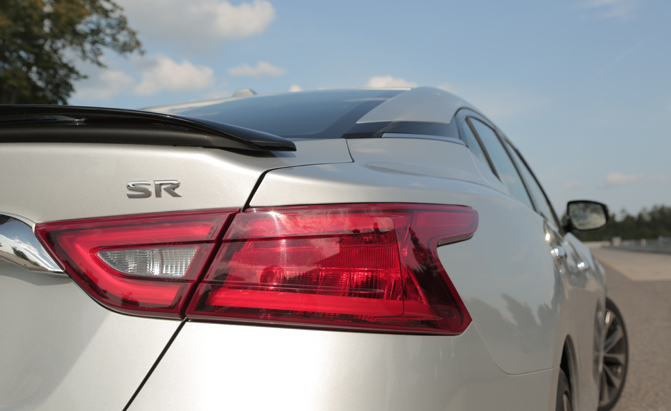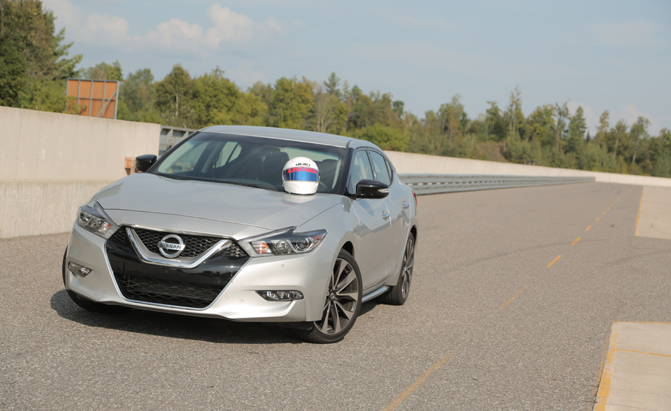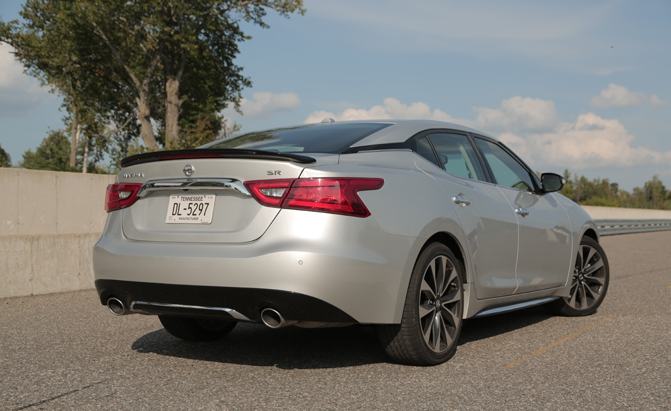When we planned to put together a list of track tips, the folks at Nissan said they wanted to be a part of it. We thought perhaps they’d ship us a 370Z and foolishly hoped for a NISMO GT-R, but instead they sent us something unexpected … a Maxima.
True, it’s a family sedan, but on a racetrack most of today’s cars have more potential than their drivers and this one is no exception. In fact, Nissan’s Maxima first earned the “4 Door Sports Car” nickname back in 1989 and that model made roughly half the horsepower this one does.
Now for 2016 the 8th generation Maxima is available in a sportier SR trim. It comes with numerous exclusive features including custom suspension tuning, a thicker front say bar, larger 19-inch wheels and you can even opt for grippier high performance rubber. Plus, there’s a new Drive Mode Selector with Normal and Sport modes that controls throttle response, transmission settings, steering feel and even the amount of sound you hear from the engine. SR models even get some custom software including a torque vectoring system to help it carve a corner.
Get the Flash Player to see this player.
But what really counts is behind that boldly styled grille. Power is provided by a totally reworked 3.5-liter V6 engine that delivers 300 horses and 261 lb-ft of twist.
To make use of all that we headed to the incredibly scenic Calabogie Motorsports Park outside Ottawa, Canada. With 21 turns and 3.14 miles of surface it’s one of the longest tracks in North America and a perfect playground to demonstrate proper driving technique.
1. Check your car
Before you do anything, make sure your car is up to the task of strenuous driving by checking its tires and their pressures as well as the brake pads.
Apart from racing slicks, ultra high performance summer rubber, like the Maxima’s Bridgestone Potenzas, will deliver maximum grip…
2. Sit properly
… as will the Maxima’s well-bolstered Alcantara seats on your butt. To make sure any seat is doing its best, the seat back should be upright. You should be able to rest your wrists on the top of the steering wheel with a slight bend to your arms and your shoulders still touching the seat.
This will probably feel uncomfortably close to you, but it’s right. You should also be able to fully depress the brake pedal and still have some bend left in your leg. And as a general rule, the lower you sit, the more it forces you to keep you vision up, which is critical.
As an aside, before you to get out on the track, make sure to familiarize yourself with what all of the safety flags mean, as well as how and when to let other cars pass.
3. Hands at 9 and 3
Whether you’ve got a nice flat bottom steering wheel or not, make sure to keep your hands at 9 and 3. Don’t shuffle or slide the steering wheel through your fingers and never cross your hands over each other while driving.
Why? Well, this way you’ll always know exactly how to get your car pointed straight again.
Everyone has experienced what it’s like to forget exactly which way your tires are pointed, especially when maneuvering around a parking lot. A harmless error, it’s easily corrected at low speeds. At 60 MPH, that half-second can be bad news.
Keeping your hands at 9 and 3 will also prevent you from using too much steering input. Your car’s steering system was designed for low speed maneuvering on the street, but when you’re on a track, small inputs go a long way.
If you’re using more than a half lock of steering you’re either oversteering, also known as drifting, or understeering, which is more easily understood as plowing.
4. Know the driving line
Finally it’s time to talk about driving. And here the key is to follow what’s known as a driving or racing line. It’s the fastest path around a track and it’s often not what you think.
On most tracks set up for lapping, cones will be laid out in certain areas and they fall into one of three categories. A turn-in cone is self explanatory. You can also think of it as the point on the track where the car changes direction. The next cone is the Apex, marking the innermost point of the corner and it’s critical. Finally, there’s the exit cone, which indicates the spot where you can re-apply full throttle – if you’ve got your wheel pointed straight ahead, which at this point it should be.
Many corners on a track are late apex corners. If you look at a conventional u-shaped turn, it’s easy to see where the middle of the corner is, but that is not the apex. The apex is further on and will allow your car to take a larger arc and carry more speed.
Knowing a corner has a late apex and actually having the patience to wait for it are two different skills.
5. Use All of the Track
While it’s a good idea to stay away from big bulging curbs as they can upset the car or actually push you off line, don’t shy away from smaller curbs, rumble strips or those painted stripes.
Hug those apexes tight, otherwise you’ll risk running out of track at corner exit. Even a couple inches can add up to tenths of a second each lap, which is huge.
It’s important to note that the stiffer your car’s suspension, the more it will be unsettled by bumps. The new Maxima actually has a system called Active Ride Control that can pulse the car’s brakes to help stabilize the suspension after a bump. Combined with a relatively compliant setup, it can easily tackle most of the curb areas at Calabogie.
6. Look Where You Want to Go
The next part is critical and something that could have mentioned first: vision. The farther ahead you’re looking the more time you have to react to what’s coming next.
So when you’re headed into a corner, you should already be looking at the corner exit, not at the apex cone. It’s easy to fixate on what’s immediately in front of you, but that won’t give you enough time to react properly.
If you want to go somewhere, look there. Likewise, if you want to avoid something, don’t look at it.
7. Braking Technique
Now let’s talk about slowing down. Heading into a braking zone, it’s important to apply your brakes firmly early on and ease up after. A common mistake is braking too hard too late.
Doing this often means an overslowed car with the driver then lifting off the brake quickly, causing the front suspension to spring up, which reduces pressure on the front tries, reducing grip and creating understeer. With the car not headed in its desired direction, most notice drivers will then try and add too much throttle or too much steering, which just makes things worse.
8. Trail Braking
It’s important to note that you DO NOT have to do all your braking in a straight line. What’s known as trail braking is the method of slowly releasing the brake past the turn-in cone.
This is less about slowing the car and more about ensuring a smooth transfer of weight and maximizing the front tires’ grip. Don’t freak out if you can’t get this right away; it’s tough.
9. Proper Acceleration Technique
Once you’ve slowed down for a corner, smoothly turned in and nailed the apex it’s time to accelerate again. At this point don’t just hammer down on the gas as soon as you can. You have to squeeze on the throttle as you open up the steering, otherwise you’ll ask too much of the tires and get wheelspin.
Think of the steering wheel and throttle as being connected. As you move the wheel back to center, the pedal should go down.
And corner exit is critical. Any speed you gain at the start of a straightaway will be amplified at the end of it. So the most important corners are the ones before the longest straightaways.
To help achieve a proper arc through a corner, many modern cars, like the Maxima use Torque Vectoring, or as Nissan calls it Active Trace Control.
While a conventional limited slip differential distributes power left to right with more power going to the outside wheel, a torque vectoring system achieves the same result by using the brakes to slow the inside wheels in a corner, making the car rotate more easily.
10. Learn Your Car
Finally, you need to learn the feel of your trusty steed. First time track drivers often start below the level of grip and then drive overly aggressively, past the point of grip, then slow down and do it all over again.
Driving fast on a racetrack is essentially being able to feel the edge of the grip and stay on it for as long as possible, which takes practice. You’ve got to learn to feel what you car is telling you, sensing the grip of the tires through the steering wheel and even the seat.
And Don’t Forget. . .
Track days are a lot of fun, but there are two enemies when it comes to going fast on a racing circuit: emotion and exhaustion. Both apply to you and the latter to your car.
Don’t do too many consecutive laps or you’ll ruin your tires and overheat your pads — something you’ll know because the brake pedal will start to feel spongy and your braking distances will get a lot longer, as will your lap times.
Remember to run a cool down lap and never apply your parking brake on red hot brake rotors.
If you take the time to learn and practice it’s not hard to chase down some significantly more powerful cars and have people thinking even a family sedan really is a 4 Door Sports Car.







